The age of limitless hope
Image: Disney
To understand Walt Disney’s aspirations, you must appreciate the zeitgeist of the era. The space age stood apart as a time of unbridled optimism. As mankind prepared to conquer the moon, citizens across the globe appreciated the fact that dreamers had it within them to bring their ideas to life. Perhaps the only other similar instance of such hope occurred with the advent of internet technology, which connects people from all walks of life. Today, people build websites to relay ideas and dreams to one another, but in the 1960s, dreamers fantasized of creating a better tomorrow. The difference between Walt Disney and the other idealists is that he had the power to bring such purposeful ideas to fruition.
The same concerns were on Disney’s mind as much as anyone else’s at the time. He wanted future generations to live in a place free from crime or slums. In order to achieve that, everyone at his new location would need to hold a job and pay rent. His concept required zero percent unemployment levels and a group of residents willing to cede their rights as land owners.
The second point was important, because the people living at the Florida Project wouldn’t own any land. Instead, they’d pay monthly rent. Disney employees would call all the shots with regards to matters of community and law. Imagineers didn’t expect this to be a problem since everyone living at Walt Disney’s new world would also work for Disney or, at the very least, one of their corporate partners. They had a plan for 100% employment that seemed viable. Every resident would work at the airport, the hotel and convention center, the merchant exchanges, or the theme park. Anyone who didn’t have a job at one of these locations would interact with visiting corporations in the industrial park. In this manner, a total of 20,000 would become the first East Coast cast members, although they’d consider themselves utopians.
A renter’s dream
Image: Disney
Why would people move to a place where they could never own property and have limited job opportunities? The key would be the appeal of the Disney brand. From the company’s perspective, the real world included many horrors such as hectic lifestyles, evil temptations, criminal transgressions, and filthy metropolitan areas. Compare those problems with the wildly popular Disneyland. It’s absurdly clean and free of crime. And while a vacation there can feel a bit hectic at times, there are no evil temptations at the Happiest Place on Earth.
From an unbiased perspective, Walt Disney had already introduced the public to one utopia. He simply needed to duplicate the feat east of the Mississippi River. Of course, an entrepreneur like Disney wouldn’t just settle for a carbon copy of his existing theme park. He had higher expectations for the Florida project. The new location would include a place that would entertain children of all ages. This new Florida gate would work as little more than bait, though.
The real prize would be the community enticed to pack up and move to a new location. These first generation tenants of the Florida Project would care more about improving the world than the petty political squabbles that so frequently stand in the way of progress. Even Disney himself demonstrated a willingness to relax his public affairs opinions as a means to bring his dream project to life. That pragmatism would have greatly enhanced the new community had he lived long enough to build it.
Image: Disney
The only lingering question about the project is what would have happened had the citizens aged into retirement. Disney was emphatic about the fact that every resident of E.P.C.O.T. would work and that no retirees would live there. He projected that the city would function as a forward-thinking business center that would evolve into the premier testing ground for new ideas. Think about Silicon Valley of today, only with better planning and a much saner real estate situation.
No plan existed to gouge renters on the cost of housing. Everyone within the community would bring their own skills to the table and work to sustain the growth of E.P.C.O.T. as a whole. In exchange for their home ownership concessions, they’d live in some of the greatest housing in the world. Imagineers planned to build homes in such a way that entire sections could swap out when new styles came into vogue. If a better energy option proved viable such as solar power, people wouldn’t have to do anything. The residents of the prototype community would simply return home to find new solar panels on their roof. Similarly, even major appliances would slot into walls in such a wall that they were easily interchangeable, something homeowners of today still can’t even imagine.
This utopia actually sounds a bit socialist in nature, an oddity given Disney’s passionate dislike of that particular ideology. Still, Uncle Walt was a pragmatist and even when he disagreed with someone or something, he listened to the other side of the argument. He believed that ideas were innocent until proven guilty. That’s what empowered him to proffer such a bold gambit with his prototype community. He also did the legwork in researching all forms of municipal charters to identify the hiccups new cities face in the early days after incorporation.
In his own words, "E.P.C.O.T will take its cue from the new ideas and new technologies that are emerging from the forefront of American industry. It will be a community of tomorrow that will never be completed. It will always be showcasing and testing and demonstrating new materials and new systems." If that sounds slightly familiar to you, it should. He also stated, “Disneyland will never be completed. It will continue to grow as long as there is imagination left in the world.”
Walt Disney was never one to rest on his own laurels. He appreciated better than perhaps any other inventor that self-satisfaction only improved the chances of status quo, and nobody grabs headlines and delights the world by staying exactly the same. For E.P.C.O.T. to sustain itself as a hub of creativity and technological breakthroughs, it must adapt constantly. This is unfortunately something that the actual Epcot hasn’t done as well as Walt Disney might have hoped. While The Walt Disney Company has addressed the matter more effectively in the 21st century, the stale nature of Future World was a running joke for many years.
Disney’s grand plan
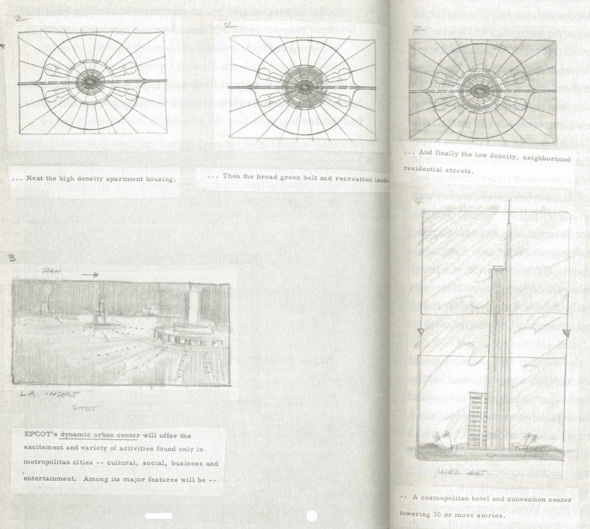 Image: Disney
Image: Disney
What would you do with 50,000 acres? That was the question Walt Disney asked himself once the massive land grab became a reality. Since 1962, he’d considered the critical aspects of infrastructure a place needs to succeed. His overriding goal was to build a property that people would want to visit. Once they were there, the hope was that they’d never want to leave. Disney wanted an even happier place than Disneyland. To his mind, people who were not residents of the Florida Project should desire nothing more than to find a way to live there. He’d hoped for a population of 20,000 in a city so well-maintained that imitators would crop up across the globe.
The blueprints for Project X aptly reflected the epic scale of Disney’s planning. You know the name of the new city, E.P.C.O.T., and you probably even know that it stands for Experimental Prototype Community of Tomorrow. Have you ever actually looked at the design Disney presented, though? The scheme should seem familiar. It’s the same hub-and-spokes style that provides the backbone of Disneyland and Magic Kingdom. The difference is in the scale of the project and how it functions as an independent legislature.
Walt Disney conceived E.P.C.O.T. as an actual city with a functional local government given autonomy by the state. With governor Burns fully supportive of the project, this part of the plan was coming together nicely. The Walt Disney Company persuaded the Florida state legislature to give them two towns complete with individual voting rights. To this day, about 50 people technically live at Walt Disney World. While the residents theoretically have the ability to make their own laws, they generally default to the ones that Disney suggests. This is precisely what Uncle Walt had in mind, only with a much larger population.
That’s where scale comes into play. Let’s put 50,000 acres into perspective. Manhattan, a borough with a population of 1.6 million, is less than 21,000 acres in size. Suffice to say that a lot of people could have lived at the community of tomorrow if Disney had wanted it that way. Instead, he wanted to spread out the options for the city, leaving plenty of room for residents to enjoy the finer things in life.
The hub of the E.P.C.O.T. development was to be the actual prototype community. That’s a bit of a misnomer, though. The residents of the city would not live at the hub. Instead, the plans called for business and commercial properties to sit in the middle. This makes sense from Walt Disney’s perspective. He viewed this Tomorrowland as an experiment of industry and commerce, too. Without appropriate monetization, the utopia would collapse into bankruptcy. For this reason, one of the primary goals for the upstart community would be to attract corporations from all over the world to interact with Disney. In this regard, Uncle Walt’s dream became a reality. Walt Disney World never has a problem signing sponsorship deals with other companies.
Moving people
Image: Disney
To have such important business people visiting, however, the former swampland would need excellent transportation options. While the existing and upcoming highways could solve some of the issues, Uncle Walt didn’t view those as forward-thinking options. He already understood the flaws of automobiles in major suburban neighborhoods. His dream city wouldn’t include the risk of children running into traffic or adults driving while under the influence of alcohol.
Instead, the driving portion of the prototype community would occur beneath the city’s business hub…and I mean an entire level beneath. The roadways would run underground, out of sight from citizens and visitors. Disney accepted that people would need to have road access in and out of his city, but he didn’t want such traffic distracting from the beautiful skylines he intended.
How would people move around within the city limits if they didn’t have cars? Come on, you should know the answer to this one. Disney’s obsession with the monorail served a purpose at E.P.C.O.T. This form of travel could transport people across the vast distances of the town in short periods. From a logistics perspective, it would function similar to subway systems and other forms of mass transit, albeit in a more energy-efficient manner.
While monorails would operate as the connector for cross-community journeys, travel over short distances required another method. Disney fans are intimately familiar with this solution as well. It’s the People Mover, a former attraction at Disneyland that still provides Magic Kingdom guests with welcome respites when they need to get off their feet. It’s a transportation system always in motion, the perfect solution for a carless commonwealth.
As originally intended, the People Mover would function similarly to elevators, escalators, and moving sidewalks. It would take the people from their neighborhoods to important parts of the city such as restaurants and theaters. In this manner, the only “traffic” in the city of tomorrow would be People Mover trams and monorail trains running on constant loops across the region. It would have been perfect… and so very Jetsons.
The two forms of interior transportation would meet at the E.P.C.O.T Transportation Lobby. This building would exist on the main level of the city, a level above the underground area reserved for automobile traffic. The monorail and People Mover as designed would allow people to hop off one and head directly over to the other, lessening the amount of walking required to navigate the city. Convenience was one of Walt Disney’s priorities in building the city of tomorrow. As he stated, “The pedestrian will be king.”
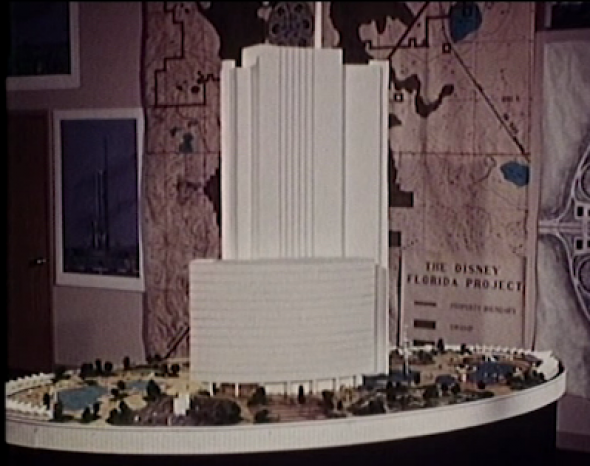
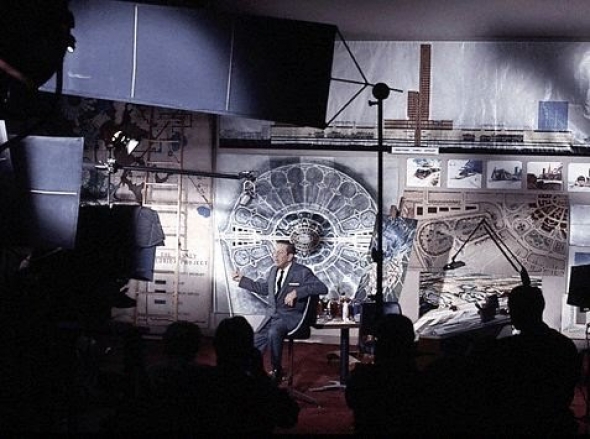
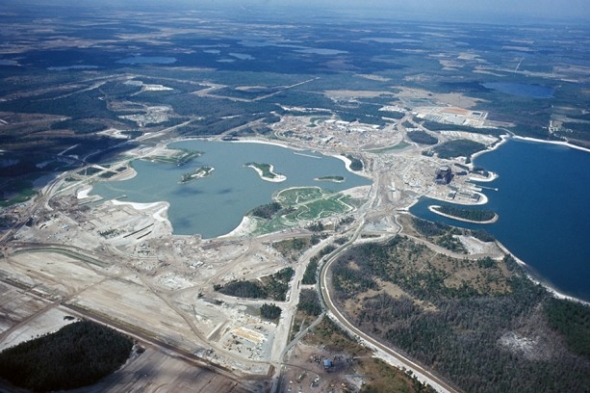
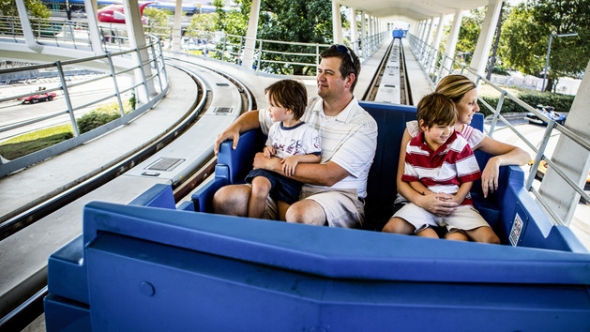

Comments
I think it would have been neat to see this come to life. I'm not sure how it would be today, but I think Disney could profit off of something like this if they tried to build it.